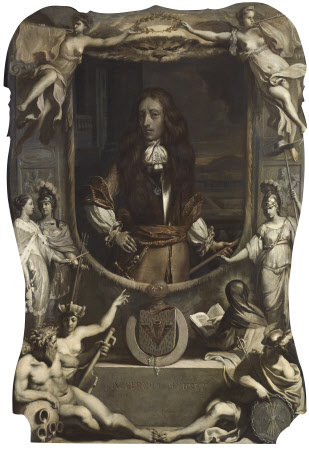An Allegorical Posthumous Portrait of Algernon Sidney (1622-1683) en grisaille
Dutch School
Category
Art / Oil paintings
Date
circa 1700
Materials
Oil on canvas
Measurements
940 x 635 mm (37 x 25 in)
Order this imageCollection
Anglesey Abbey, Cambridgeshire
NT 515441
Summary
Oil (en grisaille with camaïeu brun for the figure of Algernon Sidney) painting on canvas, Allegorical Posthumous Portrait of Algernon Sidney (1622–1683), Dutch School, circa 1700. Shield shaped portrait of young man, three-quarter length, turned slightly to the right, gazing at spectator a baton in his left hand the thumb of his right hand tucked into his waist sash, long wig. Background consists of an architectural setting on the left and open window to distant landscape with sky, on the right. Arch frame above arms and inscribed name. Various classical figures around portrait: on a tomb slab, is placed the Sidney arms, a pheon (or broad arrow). At the bottom, on either side, are, on the left, a river God with a Naiad, who points to a shield decorated with arrows (symbolizing concord or symbolizing United Provinces) and on the right, Mercury or Mars pointing to a roundel; two pairs of figures above, one, on right hand side probably represents Religion (veiled and pointing at book), with Minerva (?) holding a Cup of Liberty on a stick pointing to her. - in top corners, two figures representing Fame hold laurel wreath above head of their hero. The sitter was a politician, republican and patriot. Second son of Robert Sidney, 2nd Earl of Leicester (1595-1677) and Lady Dorothy Percy (c.1598-1659) the daughter of Sir Henry Percy, 9th Earl of Northumberland (1564-1632). He was also the grandson of Sir Philip Sidney (1554-1586). He was born at Penshurst. In 1632 with his elder brother Philip he accompanied his father as ambassador extraordinary to Chistian IV of Denmark. In 1636 he travelled to Paris and Rome with his father. In 1641 he was given a troop in his father’s regiment in Ireland. He fought on the Parliament side in the Civil War, and in 1644 was made captain of horse under the Eastern Association. Shortly after he was made lieutenant-colonel, and charged at the head of his regiment at Marston Moor, where he was wounded and rescued with difficulty. In 1645 he was given the command of a cavalry regiment in Cromwell’s division of Fairfax’s army and was later appointed governor of Chichester. In 1646 he went to Ireland and became governor of Dublin. He was appointed one of the commissioners to try Charles I but though he approved of the trial he took no part in it but instead retired to Penshurst. He disapproved of the execution of the king. Nevertheless, he played an important part under the Commonwealth until 1653, when the Republican faction was eclipsed. In 1659 he returned briefly to public life and was in Stockholm as plenipotentiary when the restoration of Charles II took place. Being doubtful of his reception at Court he stayed abroad from 1660-1677 when, just before the death of his father he obtained leave to come to England. He soon became involved in political intrigue, looking to Monmouth rather than William of Orange to take the place of James in the succession. He was known to taken part in various plottings and was implicated in the Rye House conspiracy against Charles II in 1682-3. He was tried for “conspiring and compassing the death of the king” and was forced to conduct his own case which he did with great skill. His courage and eloquence were of no avail and he was found guilty. He made two appeals to Charles II stating that he would leave the kingdom at once and forever. – all in vain. He was beheaded on the morning of the 7th December 1683. His remains were buried at Penshurst. His Discourses concerning Government, was published in 1698 (“Liars ought to have good memories” ch.2, sect.15.) Sidney was impatient, overbearing and irascible, of rough and boisterous temper, but defiance of tyranny gave him a great reputation with posterity.
Provenance
Earl Beauchamp; Henry Labouchere, Lord Taunton (1798–1869) [?the majority of E. A. V. Stanley’s possessions were inherited from him; his political sympathies would also have lain with the subject of this picture]; E.A.V. Stanley sale, Christies 25 July 1928, lot 203; with Leger, who offered the portrait to the National Portrait Gallery but must, instead have sold it to Lord Fairhaven; bequeathed to the National Trust by Huttleston Rogers Broughton, 1st Lord Fairhaven (1896-1966) with the house and the rest of the contents.
Credit line
Anglesey Abbey, The Fairhaven Collection (National Trust)
Marks and inscriptions
Recto: the plinth is inscribed, as if incised in the stone:ALGERNON SIDNEY Recto: Gilt tablet suspended from bottom of frame inscribed: ‘1622 Algernon Sydney 1683. Son of 2nd Earl of Leicester. Took up arms against Charles I and wounded at Marston Moor, 1644; Governor of Colchester, 1645; Governor of Dover, 1648; Member of Council of State, 1653 & 1659; sent to the Tower of London after discovery of Rye House Plot, and there executed in 1683.’
Makers and roles
Dutch School, artist
References
Anglesey Abbey, 1990-1992 [The National Trust; Robin Fedden] 1972, revised 1990, reprinted 1992., p.17: Anglesey Abbey, 2006 [The National Trust] 2002, revised 2006, p.10:


